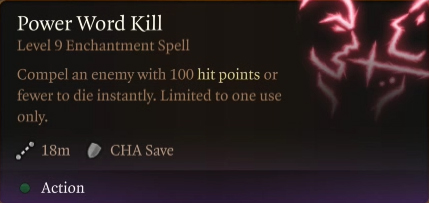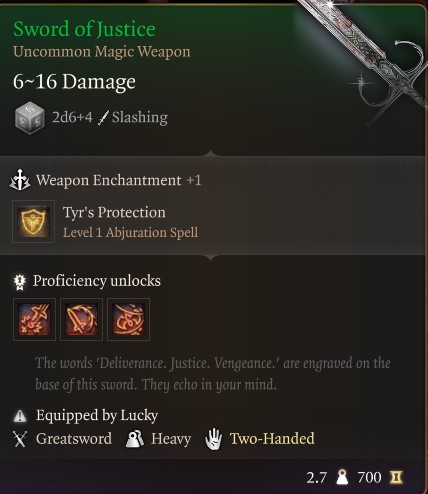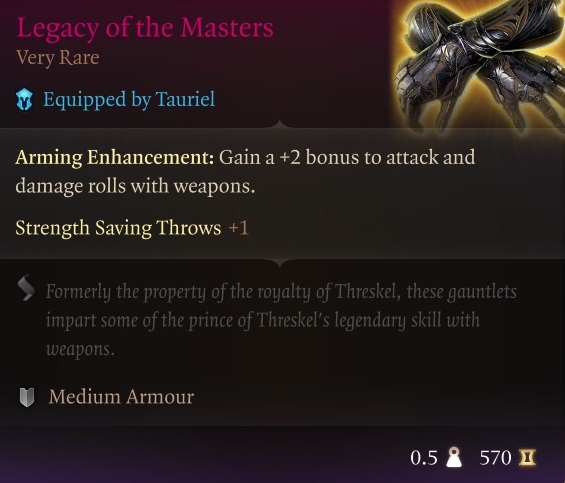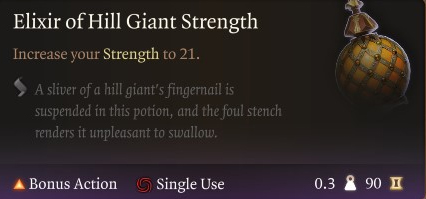This guide focuses on the key aspects of a Dark Urge build in Baldur’s Gate 3 (BG3), and how to use those powers to your advantage.

- Build Features
- Dark Urge Explained
- The Urge
- Achievements & Gear
- Class & Subclass
- Character Creation for Dark Urge Build
- Level Progression
- Best Gear
- Consumables
- Permanent Bonuses for Dark Urge BG3
- Changes in Patch 7 for BG3
- Build Summary
- What’s the best class for Dark Urges BG3?
- What is the best build for resisting Dark Urge in BG3?
- Is it possible to do a good Dark Urge in BG3?
This build page has been updated for the Patch 8 version of Baldur’s Gate 3.
Best Dark Urge Build Guide
The Dark Urge in Baldur’s Gate 3 presents a distinctive origin character experience, inviting players into a narrative rich with complexity and moral ambiguity. The distinguishing feature of the Dark Urge build lies in its overarching narrative, guiding players into the most captivating aspects of Baldur’s Gate 3. We’ve adapted the build to focus on both combat performance, but also role-play and narrative enjoyment.

Throughout your campaign, you will be confronted with choices to resist or give into “the urge.” Additionally, the game’s story will unfold around you, as the Dark Urge, and unravel the mystery of your past. With these variables in mind, we’ve created a powerful Oathbreaker Paladin build for the Dark Urge. Our class, subclass, gear, and companion selections in this guide give you strength on the battlefield and a unique experience for Baldur’s Gate 3 defining origin story.
Dark Urge Build Features
The following list presents all the essential Dark Urge Build Mechanics and Features in Baldur’s Gate 3:
- Class: Paladin
- Subclass: Oathbreaker
- Ability Score: Strength (weapon damage), Charisma (spellcasting)
- Saving Throw: Wisdom, Charisma
- Armour Proficiency: Light Armour, Medium Armour, Heavy Armor, Shields
- Weapon Proficiency: Simple Weapons, Martial Weapons
- Spiteful Suffering: the target takes 1d4 + Charisma Modifier damage each turn and gains Advantage against the enemy.
- Divine Smite: Spend spell slots to deal additional radiant damage on a successful melee attack.
- Control Undead: You can use your Channel Divinity to control undead creatures.
- Dreadful Aspect: This allows you to do an area-based crowd control CC using an action.
- Oath Spells: gain access to new always prepared spells.
- Aura of Hate: Gain additional damage to melee weapon attacks equal to your Charisma Modifier.
Related:
Dark Urge Explained

To become the Dark Urge origin character, select “The Dark Urge” in the origin section of the character creator. The default for this character starts as a White Dragonborn Sorcerer. However, you can edit the class, subclass, race and appearance in any way you wish. The primary reason to play the Dark Urge origin character is to gain a deeper understanding of the overarching narrative of Baldur’s Gate 3 story. The Dark Urge character adds another lay of complexity and added story components, most of which unfold in BG3’s final Act 3.
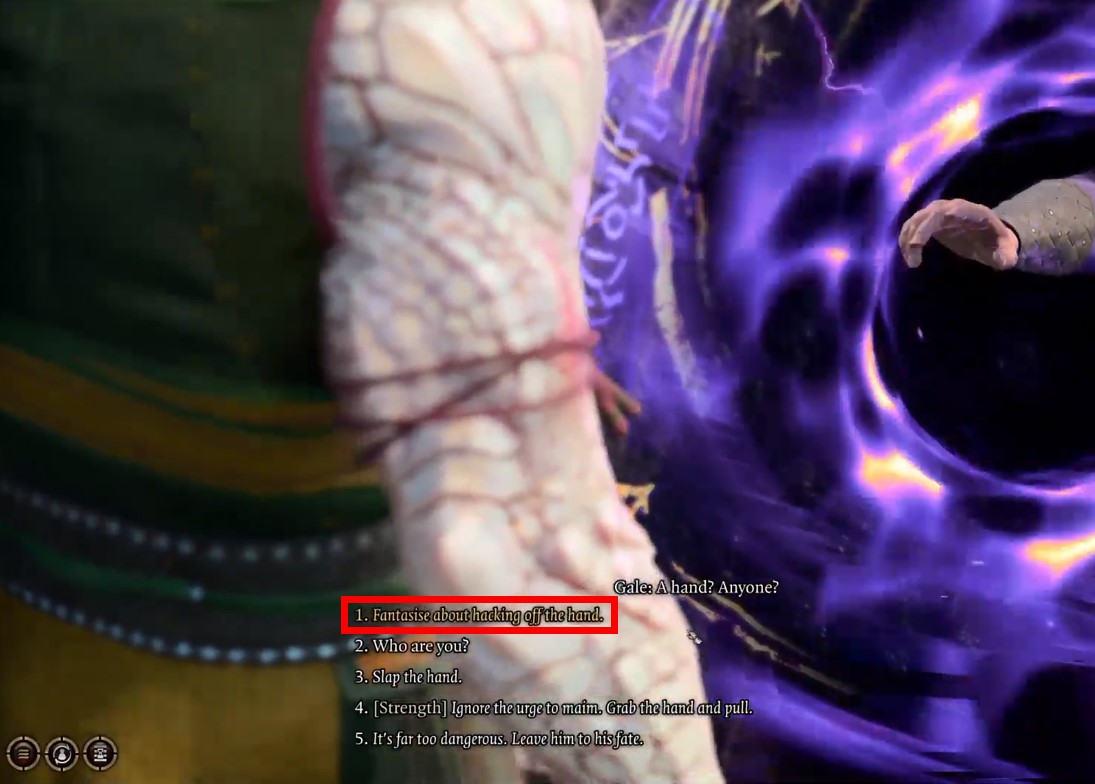
As a Dark Urge origin character, you will gain access to additional dialogue options that influence the overall story narrative. These changes are nearly all story-driven with little if any impact on gameplay mechanics. In this guide, Best Baldur’s Gate 3 Dark Urge Build, we’ve handcrafted a unique and powerful Dark Urge character in build that you can enjoy on any difficulty.
The Urge

Once you create your Dark Urge origin character, you will unlock and progress “The Urge” quest. The focal point of this quest hinges on the answer to the question: do you yield to the Dark Urge or resist? Both paths have significant consequences later in the game, and we will not spoil those in this section of the build guide. However, understand this is the overarching storyline, and that will you have to make compelling decisions throughout your campaign. Thus, we recommend picking one path and sticking with it. For our guide, we will assume you are succumbing to the Dark Urge and seeing where that path takes you.
Achievements and Unique Gear

- Achievements: Embrace Your Urge, and Sins of the Father.
- The Deathstalker Mantle: Gifted to Dark Urge player by Sceleritas Fel NPC early in Act 1.
- Slayer: A unique class action for Dark Urge which transforms the character into a medium-sized monstrosity.
- Power Word Kill: This spell kills an enemy, and can only be used once per campaign.
Class & Subclass Choice for Dark Urge BG3

The best class and subclass choice for the Dark Urge build is the Oathbreaker Paladin. This selection gives you more raw power than the Sorcerer. Additionally, you can add in specific roleplay elements by breaking your sacred Oath. You can use the leveling path below if you would like to play a Vengeance Paladin as well, with minor changes, mainly subclass-specific always prepared spells.
Below are choices for the Dark Urge build class and subclass selections:
- Oathbreaker Paladin: incredible inside and outside of combat with strong narrative ties
- Draconic Sorcerer: default selection though weaker as a solo player and overall more complex
- Necromancer Wizard: this combination focuses on raising an undead army both powerful and unique
- War Cleric: play an aggressive Cleric who can be good or evil depending on their deity selection
- Oath of Devotion Paladin: select this combo if you wish to resist the urge and play a righteous build
Becoming an Oathbreaker

To become an Oathbreaker, you must break your original Paladin Oath by lying, stealing, killing, or breaking a promise. Unlike the other Paladin subclasses, you do not choose to become an Oathbreaker Paladin during character creation. One of the easiest ways to do this early in the game at Level 2 is by by tricking the two Tieflings holding Lae’zel hostage. Another way would be to kill an innocent NPC while they are sleeping. Lastly, you can sacrifice and kill Gale during his introduction with the unique dialogue option ripping his arm off.

Once you have committed an act that breaks your Paladin oath, you will receive a visit from the Oathbreaker Knight. You’ll find him waiting for you the next time you visit your camp, typically not too far from where Withers stands. You’ll need to speak with him directly to confirm your commitment to breaking your oath. When you have done so, access the new subclass.
If at any point you change your mind and wish to take your old oath back up and return to your original subclass you can speak to the Oathbreaker Knight again at any time. However, be aware that it will cost you 1,000 gold to be able to do this. Additionally, you will no longer be able to use your channel oath charges.
Character Creation for Dark Urge Build
Race
| Category | Selection |
|---|---|
| Character | Origin – The Dark Urge |
| Race | Dragonborn |
| Sub Race (if any) | White Dragonborn |
| Class | Paladin |
| Subclass | Oathbreaker |
| Background | Haunted One |
| Ability Score | STR: 17 DEX: 10 CON: 14 INT: 8 WIS: 8 CHA: 16 |
| Skill Proficiencies | Persuasion, Athletics |

The Dark Urge’s default racial selection is the White Dragonborn. Our Best Dark Urge Build in Baldur’s Gate 3 uses this race with the Oathbreaker Paladin subclass to keep a similar archetype to the original design. Here are the best race choices for a Dark Urge build in Baldur’s Gate 3:
| Race | Features | Description |
|---|---|---|
| Dragonborn | Frost Breath Draconic Ancestry (White) | Chosen for narrative and appearance |
| Half-Orc | Menacing Darkvision Relentless Endurance Savage Attacks | Strongest for melee two-handed build |
| Githyanki | Astral Knowledge Githyanki Psionics Martial Prodigy | Best for mobility and increased movement |
| Zariel Tiefling | Darkvision Hellish Resistance Legacy of Avernus | Fire Resistance and free smite spells |
| Duergar Dwarf | Dwarven Combat Training Superior Darkvision Dwarven Resilience Duergar Resistance Duergar Magic | Invisibility and Enlarge spells |
Background

The Haunted One Background is a unique Dark Urge-only choice. This background grants skill proficiency in Intimidation and Medicine. Intimidation is a Charisma-based skill while Medicine is a Wisdom-based skill. Having high scores in these abilities influences how likely you are to pass a skill check.
Additionally, completing certain actions associated with your background will reward inspiration. Inspiration points are gathered up to a maximum of 4 and can be used for additional dice rolls in dialogue. In summary, the Dark Urge origin character, skills, and background reward you with inspiration for taking an evil approach to situations when available (mainly killing).
Ability Score
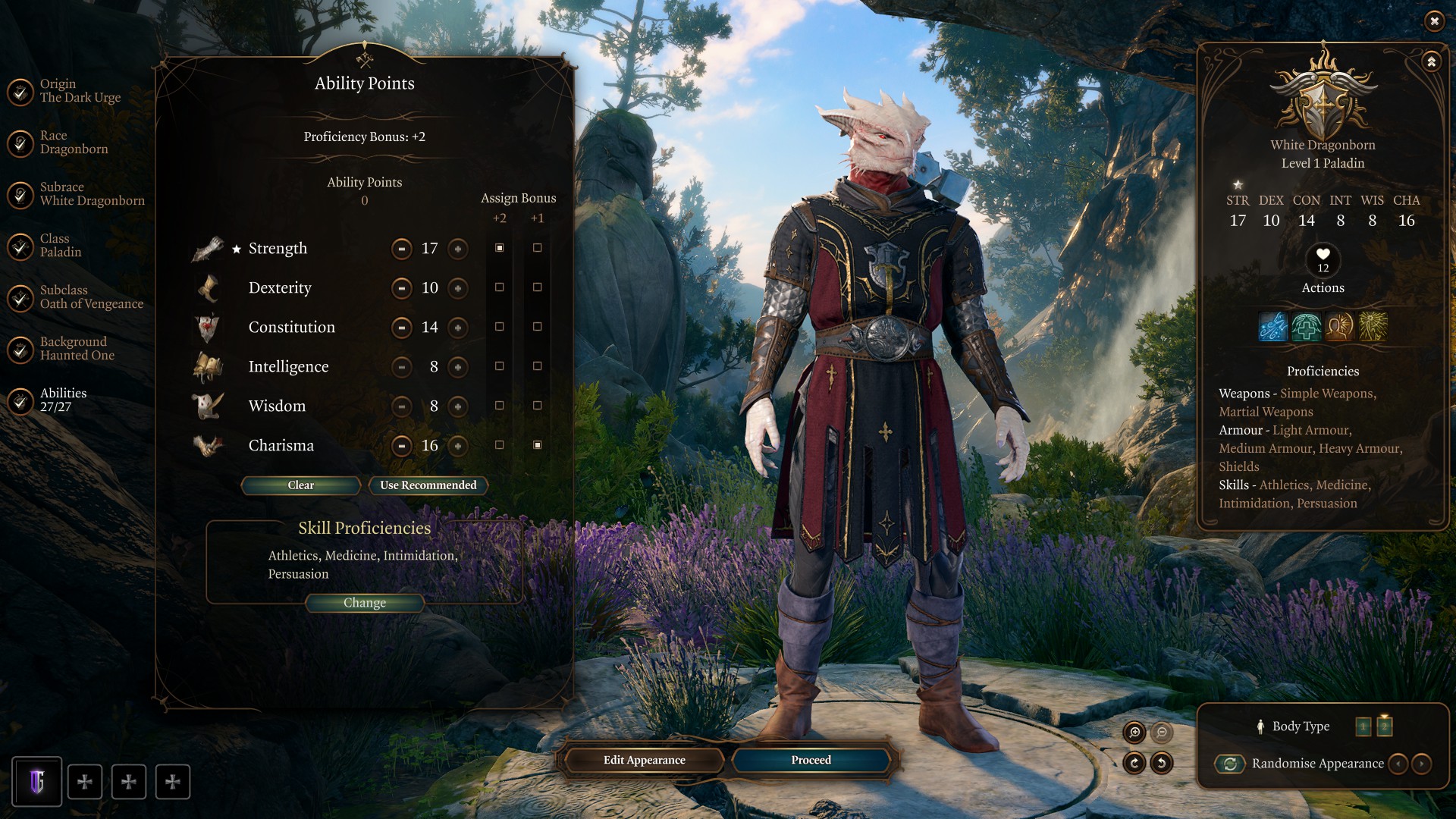
The Best Ability Score for a Dark Urge Build is 17 Strength, 16 Charisma, and 14 Constitution. Strength is your primary damage ability score, increasing it helps with landing melee attacks and damage. Charisma influences spells chance of landing and damage alongside dialogue options. Constitution is helpful because it increases your hit points and concentration saving throw chance. We recommend lower Dexterity with the Alert feat later in the game alongside heavy armor for Armour Class (AC).
Below is the best ability score for a Dark Urge build in Baldur’s Gate 3:
- Strength – 17
- Dexterity – 10
- Constitution – 14
- Intelligence – 8
- Wisdom – 8
- Charisma – 16
Moreover, this Dark Urge build assumes you will be obtaining Permanent bonuses throughout your campaign. Specifically, in Act 1 Auntie Authie can be bargained with to increase your strength to 18. Additionally, in Act 2, you can increase your Strength by another +2 via a drink, via an NPC in Moonrise Tower. Lastly, in Act 3, you can increase your strength by another +2 with Mirror of Loss. These increases are helpful because they free up your feats for increased damage selections rather than ability scores.
Skills

The best skills for the Dark Urge build in Baldur’s Gate 3 are Persuasion and Athletics. Persuasion helps influence dialogue and works in conjunction with Intimidation. Athletics is helpful in combat preventing you from being shoved or moved. These are the best skills for the Dark Urge because they complement your build when exploring the environment.
Best Companions for Dark Urge Build in Baldur’s Gate 3

The best companions for the Dark Urge Build, are Minthara, Atarion, and Lae’zel. Depending on your class selection, you may need to respec or reroll the companions with Withers at your camp. Ideally, your party composition will be balanced with an intelligence-based Wizard, Wisdom Cleric, and Dexterity Rogue. This will help your party outside of combat exploring, dialogue options, and quests. Additionally, evil-based characters will want to select companions that won’t abandon your party based on your decisions.
Below are the best companions for a Dark Urge build in Baldur’s Gate 3:
- Minthara (Cleric): Buffs, healing, and crowd control. She is a non-origin character who is first located in Act 1 and then can be recruited late in Act 2. Shadowheart serving the deity Shar is a good replacement option.
- Lae’zel (Wizard): Reroll to provide range magic damage, area damage, and crowd control.
- Astarion (Rogue): Burst damage, lockpicking, and range if needed.
Related:
Best Dark Urge Build – Level Progression in Baldur’s Gate 3
| Level | Class | Selection |
|---|---|---|
| 1 | Paladin | Oath of Vengeance |
| 2 | Paladin | Fighting Style: Great Weapon Fighting Prepared Spells: Command, Cure Wounds, Searing Smite, Thunderous Smite, Diving Favor |
| 3 | Paladin | Shield of Faith |
| 4 | Paladin | Spell: Protection from Evil and Good Feat: Great Weapon Master |
| 5 | Paladin | Magic Weapon, Aid |
| 6 | Paladin | Lesser Restoration |
| 7 | Paladin | Compelled Duel |
| 8 | Paladin | Spell: Branding Smite Feat: Alert |
| 9 | Rogue | Skill Proficiency: Deception Skill Expertise: Intimidation, Persuasion |
| 10 | Rogue | – |
| 11 | Rogue | Subclass: Thief |
| 12 | Rogue | Feat: Savage Attacker |
Level 1

At level one, follow our character creator to pick the Dark Urge origin, Haunted One background, race, skills, and ability score focusing on Strength and Charisma. Pick the Vengeance subclass here. Unlike every other subclass in the game, Oathbreaker requires you to be level 2 or higher and break your Oath. This method is explained above, but simply lie, cheat, stealth, or kill an innocent NPC.
Moving on to the second level, you’ll gain the majority of your spells. Initially, focus on weapon damage in the early game. Your chosen subclass will grant “always prepared” spells that won’t occupy a slot in your spell book.

Next, acquire heavy armor and a two-handed weapon Greatsword. The first option is the Everburn Blade, the Sword of Justice, and Silver Sword all in Act 1. You can grab medium armor from Lae’zel in the introduction and remove her from your party after the prologue. Then look to access the Hollow in the Druid Grove at the north of the starting spot post tutorial. There you will find Dammon and others will sell good armor.
Paladin Level 1
Here’s what you unlock as a level 1 Paladin:
- Channeled Oath Charges: Paladin-specific resource that allows the casting of spells and abilities.
- Lay on Hands: Use your blessed touch to heal a creature or cure it of all diseases and poisons.
- Divine Sense: Gain Advantage on Attack Rolls against celestials, fiends, and undead.
- Inquisitor’s Might: You or an ally’s weapon attacks deal an additional 2 Radiant damage and can Daze enemies for 1 turn.
- Oath of Vengeance Tenets: No Mercy for the Wicked.
Also Check:- BG3 Interactive Map
Paladin Gameplay
While this initial level may lack spellcasting abilities and might appear modest, it lays down the groundwork for a swift and significant increase in power. You’ll want to race to level 5 as quickly as possible. This is where the Paladin shines with increased spell slots, mobility, and Extra Attack. Our build will eventually use multiclassing after level 8, transitioning to the Rogue Thief combination. This allows for additional bonus action, making it easier to use the Great Weapon Master feat, cunning dash, consumables, and more.
At level 1, your primary objective revolves around familiarizing yourself with various resources and skills. Channeled Oath Charges act as your main resource, predominantly used for subclass abilities. Lay on Hands emerges as a highly valuable tool for self-healing, accompanied by its associated charges. Your chosen Oath dictates your playstyle and subclass selection. Gameplay during this phase centers on engaging in combat with a Heavy Crossbow or Two-Handed Greatsword. You can use Lay on Hands for self-healing, and gain access to Divine Smite and spellcasting at level 2.
Your overall priority with the best Dark Urge Build in Baldur’s Gate 3 build is the following:
- Complete Prologue
- Recruit Other Companions & Respec
- Reached Hollowed City/Druid Grove
- Unlock summons, Scratch, Shovel
- Collect the Necromancy of Thay (important in Act 3)
- Buy Potions of Speed, Elixir of Bloodlust, and Healing Potions
- Progress to level 5
- Check all Permanent Bonuses in Act 1
- Reach Underdark and Grymforge
Following these steps ensures a strong foundation for her especially if you plan on playing solo or on Honour Mode difficulty.
Level 2

At level two you gain access to five prepared spells and you can unlock your Subclass. To unlock the Oathbreaker Subclass, you need to break your Oath. The fastest way is to betray the Tiefling holding Lae’zel hostage. Additionally, you can lie to goblins blocking the goblin camp and kill them immediately following. Above our character creator walks you through these steps. Therefore, if you don’t see the popup, that is why, you need to pursue it, unlike other subclasses in the leveling menu.
- Command (spell selection): Command a creature to flee, move closer, freeze, drop to the ground, or drop its weapon.
- Thunderous Smite (spell selection): Your weapon rings with thunder as you strike, pushing your target 3m away and possibly knocking it Prone.
- Searing Smite (spell selection): Your weapon flares with white-hot intensity dealing 1d6 Fire damage and marks the target with Searing Smite.
- Divine Favour (spell selection): Your weapons deal an additional 1d4 Radiant damage for 3 turns.
- Cure Wounds (subclass feature): heal for 1d8 + Spellcasting modifier hit points.
- Divine Smite (class feature): deals 2d8 Radiant weapon damage and consumes a spell slot.

At this level, you gain a powerful crowd control skill Command. This is helpful when you need to disarm or stun an enemy. Thunderous Smite should be used as your go-to attack from stealth. Try to start combat in stealth, with a melee attack via Thunderous Smite for huge damage and triggering the Surprise status effect.
Paladin Strategies
Next, Divine Smite is unlocked and you need to toggle “ask” in the reactions tab in the menu. This essentially does extra damage by consuming a spell slot when you land an attack or critically strike. Early on, don’t rely on this extra damage source because you have limited spell slots. Activate Divine Smite when another bit of damage will kill an enemy.
Cure Wounds is a useful self-heal. However, you should rely on Lay on Hands or potions early during your play session. You can pre-buff before combat with Divine Smite for extra damage. However, it’s recommended to rely on Divine Smite for your spell slot consumption and simply attack in melee when possible. Lastly, you will feel slow and lethargic at this stage so try to obtain Amulet of Misty Step and Haste Helm.
Level 2 Dark Urge Prepared Spells: Command, Thunderous Smite, Searing Smite, Divine Favour, and Cure Wounds.
Level 3

Upon reaching Level three you will unlock another Level 1 spell slot, Divine Health, and subclass features. Below are your unlock skills and features at this level for the Dark Urge Build:
- Hellish Rebuke: The next time you take damage, you use your Reaction to surround your attacker in hellish flames that deal 2d10 fire damage. Amazing utility skill that does some damage back to attackers for you with a reaction, not an action.
- Inflict Wounds: 3d10 necrotic damage within melee range. This is a very high spell tooltip at the beginning and usually, a Cleric spell. On a Paladin stick with Smite if you have it.
- Dreadful Aspect: Let your darkest emotions burst forth as a menacing pulse to Frighten nearby enemies. A great are-based spell that uses channel oath charges (not spell slots). This causes fright which can lock in enemies in place for you.
- Control Undead: Use the power of your Oath to gain control over an undead creature. The undead will follow you around and attack your enemies. A channeled Oath charge which is awesome because you can get a summon that helps with damage passively. You will need to find an undead creature and cast it which will maintain its following you until a long rest without the need for concentration. Highly recommend using your oath charge on this ability.
- Shield of Faith (spell selection): Use a bonus action and increase your Armour Class by 2. This requires concentration and should be used before fights where you expect to take the majority of the damage.
Gameplay for Level 3 Dark Urge Build

At this level, the focus is primarily on dealing damage through melee attacks and divine smite combinations. You’ll find yourself limited in spell slots, so it’s crucial to manage them wisely. Ensure to adjust your Reaction settings to “Ask” for Divine Smite to avoid consuming spell slots unnecessarily while still benefiting from its extra damage.
As you progress through levels, you’ll gain more spell slots, making it easier to manage and deal with damage efficiently. However, this also means you’ll find yourself relying on long rests frequently. Therefore, it’s essential to stock up on supplies to sustain yourself during your journey.
Use Thunderous and Searing Smite only on big enemies where you need to kill them in one turn only if you do not intend to use a bonus action.
Level 3 Dark Urge Prepared Spells: Command, Thunderous Smite, Searing Smite, Divine Favour, Cure Wounds, and Shield of Faith.
Level 4

Reaching Level four gives you a very important decision between increasing your ability score like Strength or taking a feat. Feats give you a big benefit but doing so will have you miss out on Ability Improvements. This build assumes you are completing the permanent bonuses in BG3, specifically Auntie Ethel in Act 1 which will boost your Strength to 18. Therefore, we recommend taking Great Weapon Master feat.
- Great Weapon Master (feat selection): When a melee attack scores a critical hit or kills a creature, you can make another melee attack as a bonus action. When attacking with Heavy Weapons you are proficient with, attack rolls take a -5 penalty, but their damage increases by 10.
- Protection from Evil and Good – Protect an ally against the attacks and powers of Aberrations, Celestials, Elementals, Fey, Fiends, and Undead.
Level 4 Dark Urge Prepared Spells: Command, Thunderous Smite, Searing Smite, Divine Favour, Cure Wounds, Shield of Faith, and Protection from Good and Evil.
Great Weapon Master Explained

Great Weapon Master (GWM) significantly boosts our ability to defeat enemies and adds considerable value to your bonus action. Upon killing an enemy or landing a critical strike, you gain the opportunity to make a free GWM attack using a bonus action. The next level introduces Extra Attack, allowing two attacks with a single action, thereby increasing the likelihood of triggering this effect and providing a substantial boost to overall damage.
GWM has an additional aspect that enhances damage but makes your attacks more challenging to hit. You can turn this feature on or off, and depending on your initial Strength and other factors, it might be quite low. If that’s the case, toggle it off until you increase your Strength, Blessed Spell, or Elixir of Heroism. The consumable section below also includes potent items that can enhance your chances of landing attacks and overall damage.
For utility, Protection from Evil and Good is our chosen spell at this level. The Paladin’s spell choices become less impressive as you progress, and we typically rely more on Divine Smites than utility spells. This becomes especially apparent at the next level when you can attack twice per action, diminishing the effectiveness of casting spells and their power potential.
Level 5

At level 5, the Oathbreaker Paladin unlocks Extra Attack, two level 2 spell slots, one new prepared spell, and two always prepared subclass spells.
- Extra Attack (class feature): You can attack twice, by the Attack action on your turn.
- Crown of Madness (Oath Spells): Instill madness in a humanoid enemy, making them attack the creature closest to them (other than you), even if it’s allied and requires a concentration of 3 turns.
- Darkness (Oath Spells): Create a cloud of magical darkness that Heavily Obscures and Blinds creatures within. Creatures cannot make ranged attacks into or out of it.
- Magic Weapon (Spell Selection): The weapon becomes magical, receiving a +1 bonus to Attack rolls and Damage Rolls.
- Aid (drop Protection from Good and Evil): Bolster your allies with toughness and resolve to heal and increase their Hit Points maximum.
Paladin Extra Attack Explained
Level 5 marks a significant power surge due to the acquisition of Extra Attack. With two attacks per action, coupled with the possibility of a third attack triggered by Great Weapon Master, you’ll have three opportunities to unleash Divine Smite, resulting in massive single-target damage. Additionally, you can pre-buff using Magic Weapon for more damage or Aid for additional HP. Conserve your spell slots and use Crown of Madness or Darkness when crowd control is critical.
Level 5 Dark Urge Prepared Spells: Command, Thunderous Smite, Searing Smite, Divine Favour, Cure Wounds, Shield of Faith, Magic Weapon, and Aid.
Level 6

At level 6 unlocks one new prepared spell and Aura of Protection. Aura’s are passive bonuses to your Paladin and potentially allies. You will need to activate them on your action bar to gain the benefits. Below are what we suggest at his level:
- Aura of Protection: You and nearby allies gain a bonus to Saving Throws equal to your Charisma modifier. Make sure to activate it once unlocked in the passive section of the toolbar.
- Lessor Restoration (spell selection): Cure a creature from disease, Poisoned, Paralysis, or Blinded.
Level 6 Dark Urge Prepared Spells: Command, Thunderous Smite, Searing Smite, Divine Favour, Cure Wounds, Shield of Faith, Magic Weapon, Aid, and Lesser Restoration.
Level 7

At level 7, we suggest selecting the Compelled Duel spell in addition to passively unlocking the Aura of Haste.
- Aura of Hate (Subclass Feature): You and any nearby fiends (and undead) gain an additional 2 to damage dealt with melee weapons. The aura disappears if you fall Unconscious 3m radius. Useful if you are animating dead or playing with a Necromancer Wizard build.
- Compelled Duel (spell selection): Force an enemy to attack only you, giving it a Disadvantage against other targets. Only useful if you are tanking with a sword and shield. Consider this a flexible choice.
Level 7 Dark Urge Prepared Spells: Command, Thunderous Smite, Searing Smite, Divine Favour, Cure Wounds, Shield of Faith, Magic Weapon, Aid, Lesser Restoration, and Compelle Duel.
Level 8

At level 8, you gain one new spell and another feat selection. Below are our recommendations:
- Alert: You gain +5 to Initiative and can no longer be surprised. This feat helps you start earlier in combat even with low Dexterity and prevents a turn skip due to being surprised.
- Branding Smite: deals 2d6 radiant damage and Possibly marks your target with light, preventing it from turning Invisible. This is helpful to prevent bosses from turning invisible.
Level 8 Dark Urge Prepared Spells: Command, Thunderous Smite, Searing Smite, Divine Favour, Cure Wounds, Shield of Faith, Magic Weapon, Aid, Lesser Restoration, Compelled Duel, and Branding Smite.
Level 9

To further enhance your combat prowess, we’ll now multiclass into the Rogue class to acquire an additional bonus action with 3 levels of investment. Simply access the leveling panel located in the top right corner of your screen and choose the Rogue class.

Upon doing so, you’ll gain access to the Sneak Attack feature. Treat this as a passive source of additional damage that can be activated through the reactions menu. Moreover, for consistent damage output, it’s recommended to enable automatic Sneak Attack activation.

Additionally, the Rogue will gain access to skill proficiencies and expertise. We recommend taking Deception proficiency and expertise in Intimidation and Persuasion. This is helpful for a Paladin Dark Urge build with high Charisma.
Level 10

With another level of investment into the Rogue, you unlock Cunning Actions. These are useful once you obtain the Thief subclass, granting one additional bonus action per round. Dash is used for mobility, hide to avoid detection, and disengage when you need to retreat. The main usage is Dash which grants massive mobility and is quite useful for the Dark Urge build.

Level 11

With a third-level investment into Rogue, we unlock a subclass selection. The Thief is the best due to a bonus action. Below is what you unlock with this selection:
- Fast Hands (Level 3): Gain an additional bonus action.
- Second-Story Work (Level 3): You’ve mastered the art of falling and gaining Resistance to Falling damage.
The Fast Hands passives ensure that bonus action potions, smite spells, and cunning dash don’t exhaust this resource. You can now use a bonus action to Great Weapon Master Attack and a second on a potion of Speed or Oil in the same turn. Additionally, you can hide and use a healing potion for survival which is critical for combat in BG3.
Level 12
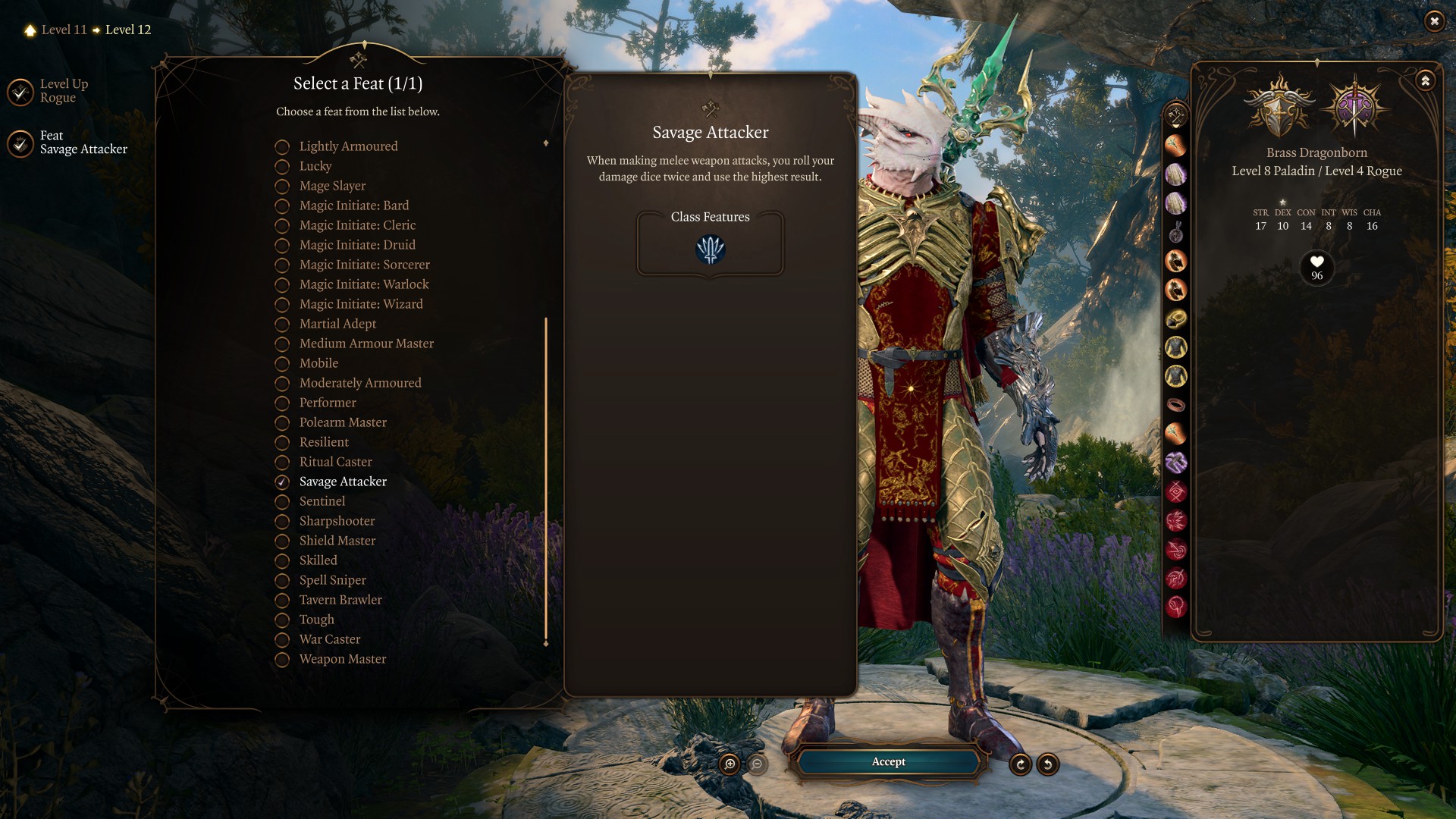
With an additional level in the Rogue class, you gain access to a feat. For this feat, we recommend choosing Savage Attacker. This powerful feat allows you to roll your damage dice twice and select the highest result, significantly enhancing your damage output. Additionally, this feat is particularly effective when you land critical strikes, amplifying the burst damage potential of your build.
Alternatively, you can opt to increase your Strength by 2. This choice depends on your preferred gear selection at the end of the game. Assuming you have the permanent bonuses unlocked, keep Savage Attacker your go-to choice.
Best Gear for Baldur’s Gate 3 Dark Urge Build

The best gear for the Dark Urge build requires you to side with a certain NPC in Act 3. Consequently, this choice will largely impact the story narrative, but unlock a powerful combination with a Trident and Piercing damage. Below is our suggestion, but does contain a spoiler.
There are three Acts in BG3, and Best Baldur’s Gate 3 Dark Urge Build Guide includes suggested sets and alternatives for Act 1 and Act 3.
Beginner: Starting the Game
Here’s the best beginner gear, items, and equipment for Dark Urge Build in Baldur’s Gate 3:
| Gear Slot | Best Gear Item | Effect |
|---|---|---|
| Head | Helmet of Smiting | Smite gives HP |
| Cape | Deathstalker Mantle | Invisibility on Kill |
| Chest | Adamantine Splint Armour | 18 AC |
| Gloves | Gloves of the Growling Underdog | Advantage on Melee |
| Boots | Disintegrating Night Walkers | Free Misty Step |
| Necklace | Moondrop Pendant | No Opportunity Attacks |
| Ring | Crusher’s Ring | Increase Movement |
| Ring | Caustic Band | Poison Damage |
| Weapon 1 Main Hand | Sword of Justice | 2d6 Slashing |
| Weapon 2 Ranged | Bow of Awareness | +1 Initiative |
- Helmet of Smiting: Located in Underdark Selûnite Outpost (Alternatives Haste Helm, Cap of Wrath, or Grymskull Helm).
- Deathstalker Mantle: Automatically acquired as part of Dark Urge story.
- Adamantine Splint Armour: Crafted in Adamantine Forge (Alternatives Chain Mail +1, or Githyanki Half Plate).
- Gloves of the Growling Underdog: Chest behind Razglin’s throne room (Alternatives Gloves of Heroism, Gloves of Dexterity, or Gloves of Missile Snaring).
- Disintegrating Night Walkers: Obtained in Gyrmforge as part of Free True Soul Nere questline (Alternatives Boots of Striding, Boots of Genial Striding, or Boots of Speed).
- Moondrop Pendant: Sealed chest inside the Owlbear Nest (Alternatives Amulet of Branding, Amulet of Misty Step, or Amulet of Restoration).
- Crusher’s Ring: Can be looted or stolen from Crusher in the Goblin camp (Alternatives Strange Conduit Ring, or Ring of Absolute Force).
- Caustic Band: Obtained from merchant Derryth Bonecloak in the Myconid Colony (Alternatives Fetish of Callarduran Smoothhands, or The Sparkswall).
- Sword of Justice: Looted from Anders near Karlach (Alternatives Jorgoral’s Greatsword, Silver Sword of the Astral Plane, or Everburn Blade).
- Bow of Awareness: Sold by Vendor Roah Moonglow in the Shattered Sanctum (Alternatives Hunting Shortbow, Bow of Banshee, Titanstring Bow).
Read More – Baldur’s Gate 3 Shadow Magic Sorcerer Build
Advanced: Endgame
The following table presents the best gear, items, and equipment for the Dark Urge Build in Baldur’s Gate 3:
| Gear Slot | Best Gear Item | Effect |
|---|---|---|
| Head | Helm of Balduran | Self-healing |
| Cape | Deathstalker Mantle | Invisibility on Kill |
| Chest | Bhaalist Armour | 2x Piercing Damage |
| Gloves | Legacy of the Masters | +2 Attack rolls |
| Boots | Helldusk Boots | Mobility |
| Necklace | Amulet of Bhaal | Inflicts Bleeding |
| Ring | Killer’s Sweetheart | Auto Critical |
| Ring | Ring Of Regeneration | Self-healing |
| Weapon 1 Main Hand | Balduran’s Giantslayer | Best Greatsword |
| Weapon 2 Ranged | Darkfire Shortbow | Gives Haste |
Below is the best Act 3 Armor, Weapons, and Equipment for Dark Urge build in BG3:
- Helm of Balduran: Obtained in Dragon’s Sanctum (Alternatives Helldusk Helmet, Sarevok’s Horned Helmet, Mask of Soul Perception).
- Deathstalker Mantle: Automatically acquired as part of Dark Urge story. (Alternatives Cloak of Protection, Fleshmelter).
- Bhaalist Armour: Side with Bhaal in the Murder Tribunal then purchase from Echo of Abazigal (Alternatives Helldusk Armour, Armour of Persistence).
- Legacy of the Masters: Purchased from Dammon in Lower City Baldur’s Gate (Alternatives Gauntlets of Hill Giant Strength, Helldusk Gloves, Gloves of Soul Catching).
- Helldusk Boots: In a locked chest, Wyrm’s Rock Fortress (Alternative Disintegrating Night Walkers).
- Amulet of Bhaal: Looted or given by Sarevok same location as Bhaalist Armour (Alternatives Amulet of Greater Health, Periapt of Wound Closure).
- Killer’s Sweetheart: Obtained from the Gauntlet of Shar in Act 2 (Alternative Ring of Protection, Risky Ring).
- Ring Of Regeneration: Sold by Rolan at Sorcerous Sundries (Alternative Ring of Free Action, Shifting Corpus Ring).
- Balduran’s Giantslayer: Obtained as a reward for completing the Wyrmway trials (Alternatives Sword of Chaos, Silver Sword of the Astral Plane).
- Darkfire Shortbow: Sold by trader Damon Act 2 Last Light Inn (Alternative Fabricated Arbalest).
Best Consumables, Potions, and Items
The following list is the best consumable items that will aid in our Best Baldur’s Gate 3 Dark Urge Build Guide:
- Elixir of Bloodlust: Once per turn when you kill a foe, you gain HP 5 temporary hit points and an additional action.
- Elixir of Hill Giant Strength: Increases Strength ability score to 21 until Long Rest.
- Potion of Speed: Gain extra action, +2 AC, Advantage on Dexterity Saving Throws, and double movement speed.
- Drow Poison: Weapon poison that adds Constitution Saving Throw or becomes Poisoned and falls Asleep.
- Potion of Flying: Drink to gain a flying speed of 60ft for one hour.
- Elixir of Heroism: Gain 10 temp HP and become Blessed until a long rest.
- Potion of Greater Healing: 4d4 + 4 hit points restored.
- Oil of Accuracy: Coat Weapon. Bonus of +2 in Attack Rolls.
- Elixir of Vigilance: Drink to gain a +5 bonus to Initiative and you can’t be Surprised.
Illithid Powers For Dark Urge Build
The best Illithid Powers for a Dark Urge build are Luck of the Farm Realms, Black Hole, and Cull of the Weak. Luck of the Farm helps with critical hits and burst damage and, combined with Cull of the Weak, can trigger AOE damage passively. Black Hole requires you to take the Astral Tadpole in Act 2, but it sucks in 5 enemies, slows them, and can be recast for free. This is helpful in certain large-scale boss fights with many enemies. Below are the best Illithid Tadpole Powers for the xxx build in Baldur’s Gate 3:
| Illithid Powers | Description |
|---|---|
| Luck of the Far Realms | When you make a successful Attack Roll against a foe, you can change that hit into a Critical Hit. |
| Cull of the Weak | When you bring a creature down to fewer hit points than your number of evolved Illithid powers, it dies and all nearby creatures take 1-4 Psychic damage. |
| Psionic Backlash | When an enemy within 9m casts a spell, you can use your reaction to inflict ld4 Psychic damage to the caster per the spell’s level. |
| Blackhole | Area-based suck-in that slows targets. |
| Repulsor | Massive area knockback that can hit friendlies. |
| Charm | This is the priority power you want to obtain because you can force enemies to attack something else. |
Permanent Bonuses for Dark Urge BG3

Throughout Baldur’s Gate 3, you will have the ability to gain permanent bonuses to your character. These can grant additional spells, ability scores, and other bonuses. Permanent Bonuses are not displayed throughout the campaign but are vital to increase overall combat performance. We have all permanent bonuses here in a guide, but the most important ones for you to collect are listed below.
| Act 1 | Act 2 | Act 3 |
|---|---|---|
| Auntie Ethel’s Hair: Gain +1 to an Ability Score. | Potion of Everlasting Vigour: Gain +2 Strength. | Mirror of Loss – +2 to an Ability Score of your choice. |
| Awakened: Use illithid powers as a Bonus Action. | Slayer Form: Ability to transform into the Slayer. | Partial Ceremorphosis: Access to tier 3 illithid Powers. |
| Scratch: Gain Find Familiar Scratch. | Summon Us: Allows you to summon Us. | Sweet Stone Features: Blessed permanent. |
| Cheeky Quasit: Gain Summon Quasit Shovel. | Statue of the Gods: +2 to Saving Throws | |
| Loviatar’s Love: 30% Hit Points or less, you gain a +2 bonus to Attack Rolls and Wisdom saving throws. | ||
| Necromancy Of Thay: access to powerful spells in Act 3. | ||
| Volo’s Ersatz Eye: See Invisibility |
Dark Urge Changes in Patch 7 for BG3

The Dark Urge Origin Character received changes to narration and dialogue as well as cut scenes. While this builds combat and gameplay elements remain unchanged, you can expect some new narration and dialogue for the Dark Urge. Below are the most important changes in Patch 7 for a Dark Urge Build:
- Added three new Narrator lines for Dark Urge characters to add a bit more reactivity across the game. These additions are described in more detail in the main patch notes below.
- When playing as the Dark Urge, Minthara will no longer act as though you accepted Bhaal when you’ve been stripped of his influence.
- When playing as the Dark Urge, if you invite her, Alfira will now actually join your party as a controllable character if there’s room for her in your party setup. Temporarily, of course.
- The Dark Urge should now be Inspired by killing Nightsong.
Read More – Top 10 builds for Baldur’s Gate 3
Best Baldur’s Gate 3 Dark Urge Build Summary
Class – Paladin
Subclass – Oathbreaker
- Act 1 – Heavy
- Act 3 – Light (unique set)
Weapons: Two-Handed Greatsword
Race – Dragonborn, White Dragon
Ability Score
- Strength – 17
- Dexterity – 10
- Constitution – 14
- Intelligence – 8
- Wisdom – 8
- Charisma – 16
Level Progression
- Level 1 – Vengeance Paladin
- Level 2 – Great Weapon Fighting
- Level 3 – Oathbreaker Subclass
- Level 4 – Great Weapon Master
- Level 5 – Magic Weapon
- Level 6 – Lesser Restoration
- Level 7 – Compelle Duel
- Level 8 – Alert
- Level 9 – Multiclass Rogue
- Level 10 – Cunning Action
- Level 11 – Thief Subclass
- Level 12 – Savage Attacker
Frequently Asked Questions
What’s the best class for Dark Urges BG3?
One of the top picks when it comes to Dark Urges in BG3 can be the Oathbreaker Paladin and Berserker Barbarian builds.
What is the best build for resisting Dark Urge in BG3?
The top builds to resist the Dark Urge in BG3 can be Oath of Devotion Paladin build as well as the Cleric build.
Is it possible to do a good Dark Urge in BG3?
Yes, Dark Urge, if used correctly can provide the most rewarding and powerful experience in Baldur’s Gate 3.
Looking For More About Baldur’s Gate 3?
Thank you for reading the Best Baldur’s Gate 3 Dark Urge Build. We provide the latest news and create guides for Baldur’s Gate 3. Also, watch me play games on Twitch or visit my YouTube channel!
 Reddit
Reddit
 Email
Email


